La Grenouille: Excellent dining experience
I’ve just returned from NYC where I was prompted by the very favorable NYTimes review of La Grenouille (“the last great French restaurant in New York”) to try it for the first time. It was the most successful dining experience I’ve had in more than five years so I thought you might like to know about it.
The amuse bouche was a very flavorful pea soup whose green color is hard to see in this picture taken with available light:
The seared foie gras was garnished with quince, which I mistook for apple. The quince had a wonderful flavor that was new to me.
The lobster ravioli were perhaps the least successful dish of the meal — there was no clear flavor — but they were really pretty!
The Dover sole is one of their signature dishes, and rather hard to find on this side of the pond, so we had to splurge. The highly-touted mustard sauce was appropriately mild but the sole was best with just a squeeze of lemon.
Although magret de canard is a great favorite and something I therefore often make at home, I’d never made it a l’orange, so that made it an attractive choice. Imagine my surprise when it appeared without an orange in sight but rather kumquats! What occurred next was even more surprising: when I mentioned the discrepancy to the waiter he returned immediately to suggest that I eat slowly because the chef was preparing an orange sauce for me!
The manager subsequently sent some muscadet to be drunk with the signature dessert souffle; the Grand Marnier was not as good as our own (it needed a big slug of orange rind) but the pistachio was outstanding.
Highly recommended! (There is an inexpensive daily lunch menu in the upstairs dining room and an attractive $59 prix fixe theatre menu served before 6pm.)
Lahey’s No-kneed Bread
As someone who’s always been interested in what might be called the effort-to-reward ratio sweepstakes, I have to report to you the newest entrant among the very best candidates: the Jim Lahey no-kneed bread method. If you’ve already got an enameled cast-iron dutch oven — I have a Copco one from the 60s — then you’re ready to roll. I would recommend investing in a decent digital scale so that you can easily measure the ingredients by weight. I’ve discovered that it takes 4 minutes to mix the ingredients for the first rise, 3 minutes to punch down and prepared for the second rise and 1 minute to put the risen dough into the pot to bake. This is almost certainly the biggest pay-off I’ve even had from 8 minutes of cooking!
Here’s the cover of the book Lahey put out after Mark Bittman had alerted the world via his Minimalist column in the Wednesday New York Times food section:
Here’s the list of ingredients for the cheese version of the bread:
And here’s the finished product:
Nice moist, chewy crumb and one of the toughest crusts you’ve ever seen:
Here’s the beginning of the Pancetta Bread:
The recipe could not be simpler. Happy baking!
Update (2/25/10): Of the various varieties all with basically the same formula, I now prefer the olive bread made with twice the amount of olives called for in the recipe (I use 1 1/2 cups). I do think it benefits from a little additional salt!
Foodies Gather at Cordon Bleu’s Technique
It goes with saying that when you go to a student-run restaurant at a cooking school, even one run by Cordon Bleu, you don’t expect professional service or cutting-edge cuisine. The former is unrealistic and the latter is just not what cooking schools are about. With this in mind, a large contingent of Foodies had a most enjoyable visit to Technique in the Atheneum Building on First Street in Cambridge. Of course it helps when stretching an hour-and-a-half meal over almost three hours to have a group of very congenial people around the table.
The menu was about as straightforward as it could be:
I had the soup which was very good — the combination of celery root and cauliflower is not one I’ve used before but I liked it enough to add it to my list. The Grilled Flat Iron (beef) was flavorful and came with a potato preparation I did not know: Pommes Fondant, apparently a block of potato braised in stock and then browned nicely on all sides; the passable bearnaise lacked the clear tarragon flavor it should have had.
The “Warm Tart Tatin” was an unobjectionable poached — or perhaps baked — apple sitting on a circle of puff pastry. Not very impressive as an example for students to emulate but my strong criticism had another focus: this dessert was not in any way related to the classic French Tart Tatin beyond being made with apples. First, I expected that here, of all places, I could count on receiving a reasonable facsimile of authentic Tart Tatine (which doesn’t require any more than entry-level pastry skills to make well); in fact, no serious attempt had been made to fulfill the “contract” I had made in placing my order. Second, and more important, that students were paying top dollar ($45K per associates degree over 15 months) to learn from what purports to be a leading French authority about classic French cuisine and then being mislead so thoroughly seemed to me a travesty. (I get similarly upset when dishes described as “risotto” turn out to have been made with Uncle Ben’s — “risotto” has a very specific meaning in Italian cooking; it does not mean “anything made with rice.”)
Returning to the restaurant’s potential value to diners, I hasten to say that it fills an otherwise empty niche very well: if you have an evening free and intend to pass the time conversing with your companions over a meal which will satisfy a wide range of conventional tastes, Technique can deliver quiet ambiance and a competently cooked meal at an attractive price.
[I hope others who were present will use the comments to add additional perspectives on our experience.]
Rare Roast Beef and Leg of Lamb
If you’re like me, then you’ve always fretted about the fact that roasting a beef rib roast meant overcooked meat on the outside and too-rare meat on the inside just to have most of the meat a beautiful pink. Well, thanks to The New Best Recipe (p.402) I’ve discovered the answer, apparently one which the big roast beef restaurants have known for decades: low and slow.
I first tried the technique on a a five-rib roast beef and it worked superbly. I then said to myself “Why not leg of lamb?” So I went to McKinnon’s in Davis Square (one of my latest discoveries: every sort of meat you could imagine, including beef tongue, at wonderful prices) and picked up this beauty:
I cleaned it up a bit (including the removal of almost all of the exterior fat), put a lot of rosemary in the middle, and tied it up. Then the garlic slivers around the surface. In order to have a pleasantly brown exterior, you need to brown it on the stovetop before roasting it. Then, put it into a 250° oven for 3 1/2 hours or until the very center reaches 128° — which was exactly 210 minutes for me. Take it out and let it sit at least 15 minutes.
And you’ll get this:
When you’re looking for ways to use the left-overs, I’d highly recommend one of my favorite menu items from Jean-Georges’s Mercer Kitchen in SoHo: a roast lamb sandwich with roasted red pepper and spicy mayonnaise (mix harissa with Hellman’s):
Now you’re talking!
What to do with left-over turkey
This one’s easy: of course, one makes a turkey sandwich (and turkey soup, and turkey pot pie, etc., etc.). I thought other foodies might take inspiration from my long-standing search for the perfect turkey sandwich.
Reading from the bottom: Pepperidge Farm seeded rye lightly toasted and sliced in half while warm (resulting in two slices each half the original thickness) spread with gravy, stuffing toasted in the toaster-oven until crisp on the outside, thinly-sliced white meat, emmenthal (swiss) cheese, crisp bacon, jellied cranberry sauce, hard-boiled egg, and mayonnaise.
A tradition of boned duck
Paul Royce explains his recent pursuit of a boned duck:
A Short History of Boned Fowl
According to culinary historians the introduction of boned fowl to haute cuisine began during the reign of Henry VIII of England. That monarch, as famous for his carnivorous propensities as for those carnal, choked on the drumstick of a duck during a bout of speed eating. He was rescued by Sir Thomas More who stood behind him, clasped his hands together and with an upward motion squeezed the King’s abdomen just below the rib cage causing the drumstick to come free of his windpipe, fly from his mouth, and land in the bosom of a young woman sitting opposite the King. This first known use of the Heimlich maneuver saved the King’s life but resulted in a riot as courtiers fought to determine who would dislodge the drumstick from the damsel’s cleavage. From that time on the King ate only boned fowl and some time later he showed his gratitude to the inventive More by executing him.
Julia Child brought boned duck preparation to the attention of American foodies with the publication of Mastering the Art of French Cooking in 1961. A guide for boning a duck can be found on page 570. I have never tried the en croute recipe that follows.
I leave the duck meat in situ and do not cut it into cubes as she recommends. With the duck skin side down, I stuff it with sweet Italian sausage augmented with shelled pistachios, dried fruit, and a generous splash of cognac. Do not suture the roast too tightly because the skin will shrink and the stuffing may expand resulting in a ruptured duck. The somewhat limp, but not too limp, preparation is baked at 400 degrees until the internal temperature reaches 180 degrees.
With a little luck you will rewarded with a preparation similar to the one pictured. I prepare the roast a day or two before serving and refrigerate it when it has cooled. Serve it at room temperature.
A trip to New York City!!
If you follow that sort of thing, then you know that this fall is a particularly rich one for museum shows: Vermeer (review) and Robert Frank (review) at the Met , O’Keefe at the Whitney (review), Kandinsky at the Guggenheim (review), and so on. If you saw this morning’s (Sept 18) Times Arts section you also saw the very favorable reviews of the latter two (do we need someone to tell us whether Vermeer is worthwhile? I can speak for Frank).
This suggests that it’s a good time to head down to Manhattan for a visit. And, since we’re foodies, it means looking out for those obscure little restaurants which have so impressed the local foodies that they’ve become destination restaurants, humble as they may be.
I’ll be guiding a group of foodies to NYC with an emphasis on “value travel” (I’m not exactly cheap, but I learned my travel habits from Europe on $5 a Day). We would leave on Friday morning October 30th around 8am, returning Sunday November 1st to arrive in Boston around 8:30p. The choice between bus or car is a draw in terms of cost; the decision will be made later. Our headquarters will be the LaQuinta hotel on Queens Blvd, Queens (on the 7 subway) because it’s the cheapest one I know with a normal level of accommodation and amenities ($135/night/double room booked today). We’ll spend a majority of our time at the museums but also hit the obligatory foodie stops in Soho (Balthazar, Dean and Deluca, MoMA design store) and elsewhere (Zabar’s). Our two dinners will be in Queens at Sripraphai (Frank Bruni’s review in 2004 in the Times) and Spicy and Tasty (no website!; Bruni again from 2006: review). I will do my best to be near other worthy places when mealtimes arrive (Lupa in the Village for Saturday lunch, EAT on Madison at 80th, near the Met, for Sunday lunch).
Here’s a tentative (but likely) schedule:
Friday
1:15pm Grand Central Oyster Bar for lunch
2:15pm 57th Street & Madison galleries (Pace, Greenbery, Benrubi); Robuchon;
3:15pm Guggenheim (Kandinsky)
5:15pm Metropolitan (Frank, Vermeer)
7:00pm Zabar’s
8:30pm Sripraphai (Thai)
10:00pm Good Night
Saturday
9:00am walk across the Brooklyn Bridge to Manhattan
10:30am Balthazar for breakfast
11:15am MoMA design store, Sur La Table, Dean & Deluca, galleries
12:20pm Lupa (Mario Battali) or Mercer Kitchen (George Vongerichten) for lunch
to Chelsea for galleries; to Brooklyn to walk across the bridge;
8pm Spicy and Tasty (Szechuan)
9:30pm Good Night
Sunday
9:45am Metropolitan (Frank, Vermeer)
12N Whitney (O’Keefe)
1:15pm EAT for lunch
perhaps PS1;
Tentative budget: lodgings: $150; bus/subway: $30; museum admissions: $60; Friday lunch and dinner: $55; Saturday breakfast, lunch and dinner: $90; Sunday lunch: $30; add Boston-NYC transportation;
More to come . . . (email me with expressions of interest)
Cooking Pizza
Some foodies gathered last Saturday at the home of Len and Judith Inker to put together a wide-range of “unusual” pizzas: not a tomato in the bunch!
Len started us off with some very unusual potato chips. Sliced on a mandoline, a pair of chips is pressed around a sage leaf and then fried. Very tasty!
Then Ann Oppenheimer whipped up a cream cheese and wild smoked salmon pizza:
Deb and I countered with mascarpone, speck and arugula, one of our all time favorites:
Heidi Vernon upped the topping quotient with her roasted squash and cheeses:
Kitty Selfridge and Pat Ruopp came forward with fig jam, proscuitto, cheese and arugula:
And Len closed out the parade with portobella mushrooms and goat cheese on a flour tortilla:
Thanks to Len and Judith for their hospitality and to Len for many batches of fine pizza dough!
Lunch at Cafe Boulud in Manhattan
If you should find yourself near 76th and Madison (a block above the Whitney) around lunchtime, there is only one reasonable thing to do. That’s to drop in at Cafe Boulud (as annoying a website as I’ve ever encountered) for a top-drawer French meal for $24. Now you may have heard that NY restaurants were taming down their prices in response to the financial crisis, but you probably didn’t think that someone like Daniel Boulud would have to react so decisively. Not only can you have a splendid 3-course meal for $24, you can have a bottle of wine for the same $24. Here’s the prix fixe menu:
So, what does it look like when it gets to the table? Here’s the amuse bouche (the 4th course?), a slice of fresh date with something-or-other plus a sorrel leaf on top (and a cayenne dusted toasted almond on the side):
Here’s the duck terrine entrée (the French version of appetizer) which was so appealing that we both ordered it:
Then we had jointly selected (Deb and I always agree on our order because each eats half of every dish) as plats the hanger steak on celery root purée with Tuscan chard and cannelini beans. The celery root purée has since become a staple of our what-to-have-with-the-steak repertoire:
Along with a very French version of potato gnocchi with spring vegetables:
As expected, the desserts were standard issue high-end (not a thrill for us): a carrot cake (note the terrific carrot chip garnish):
and a chocolate brownie:
The pièce de résistance, however, was the basket of miniature madeleines in place of petits fours:
Finally, the most pleasant dénouement imaginable:
Needless to say, we’ll be back on every trip down.

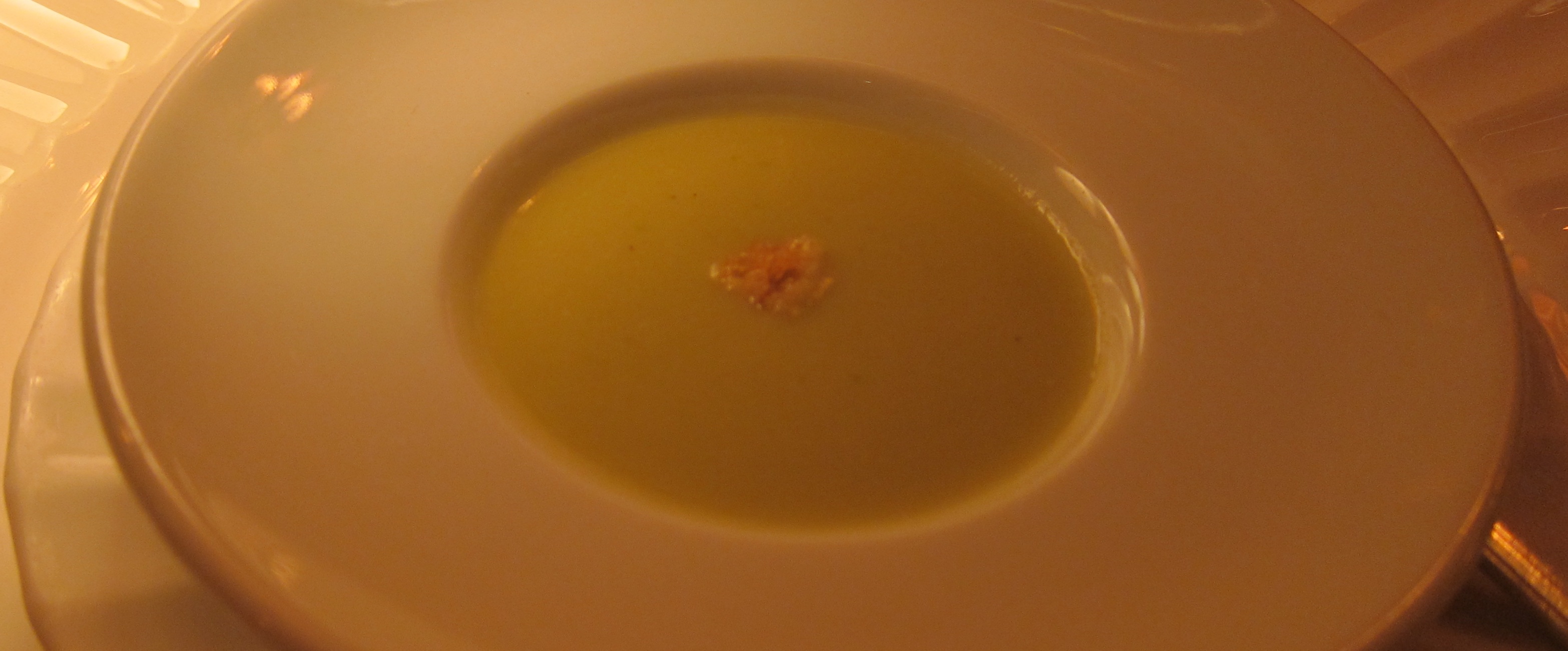
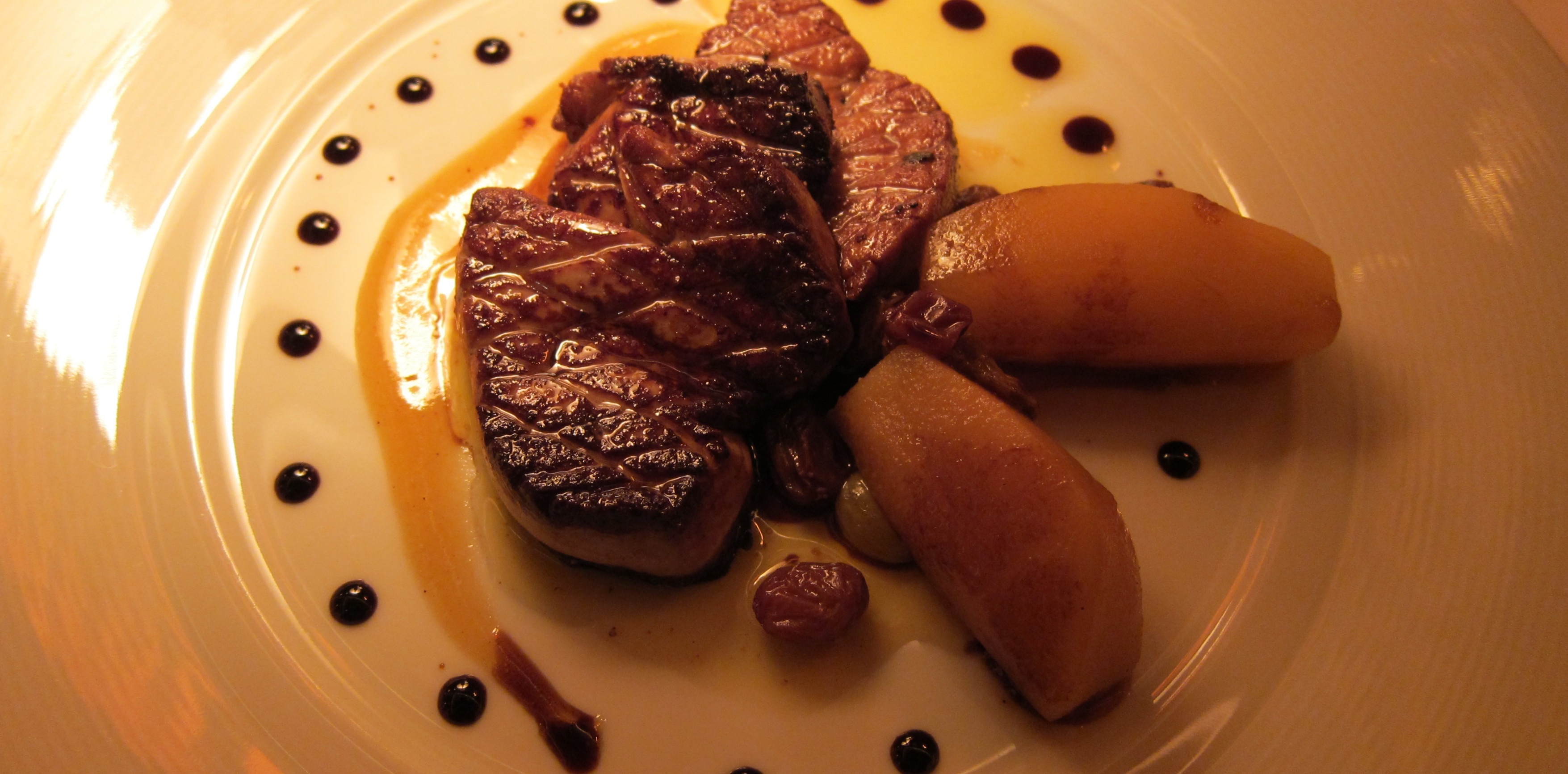
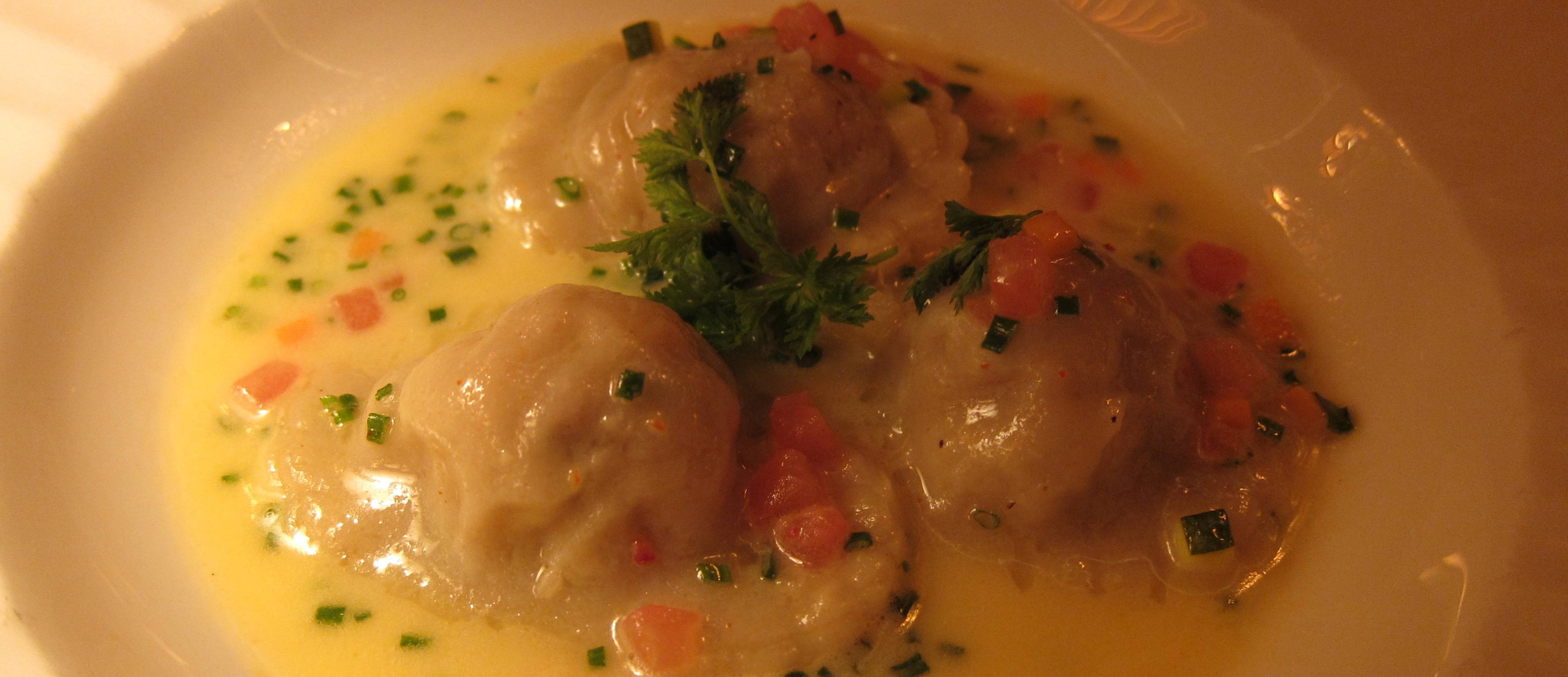
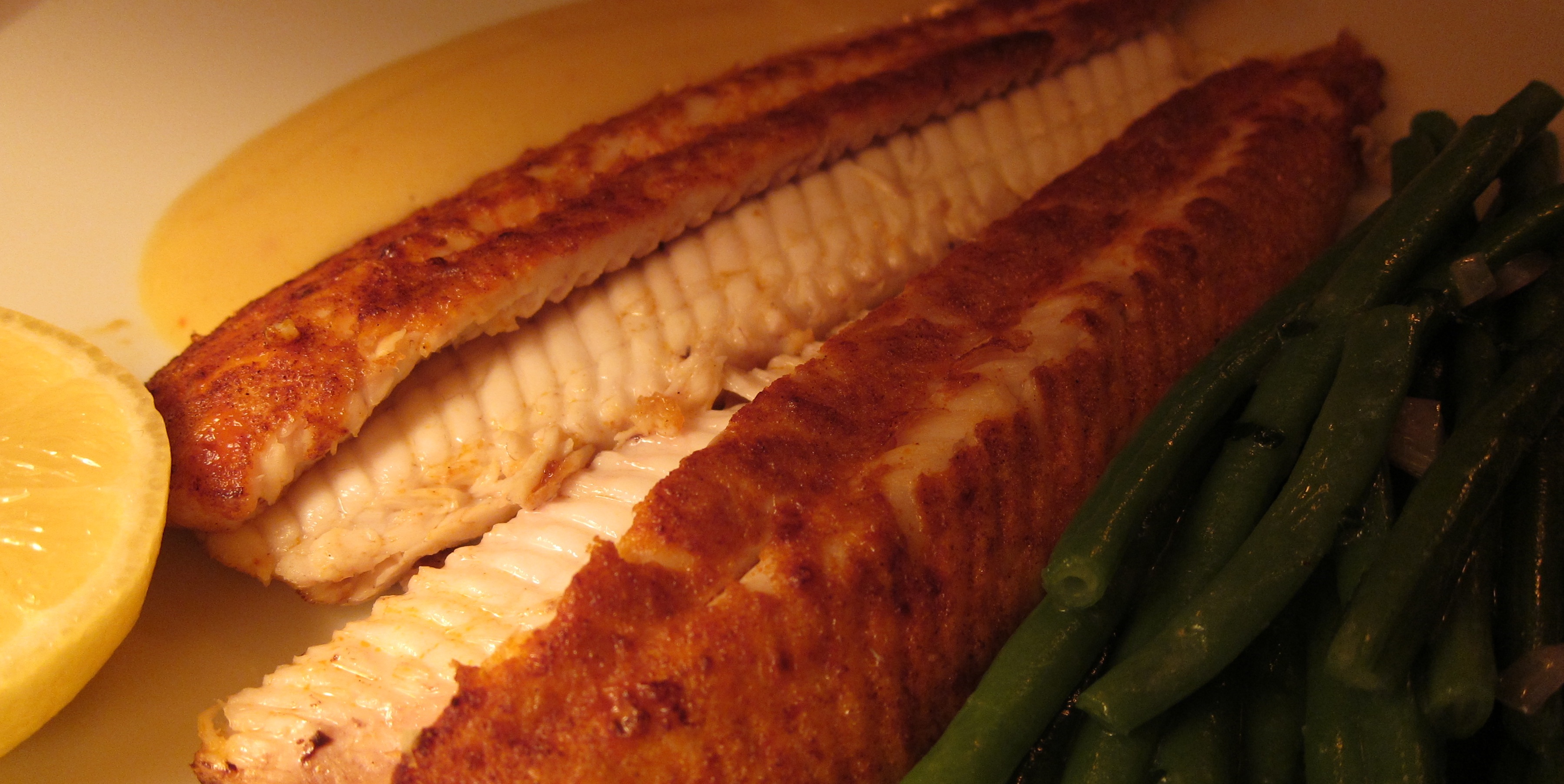
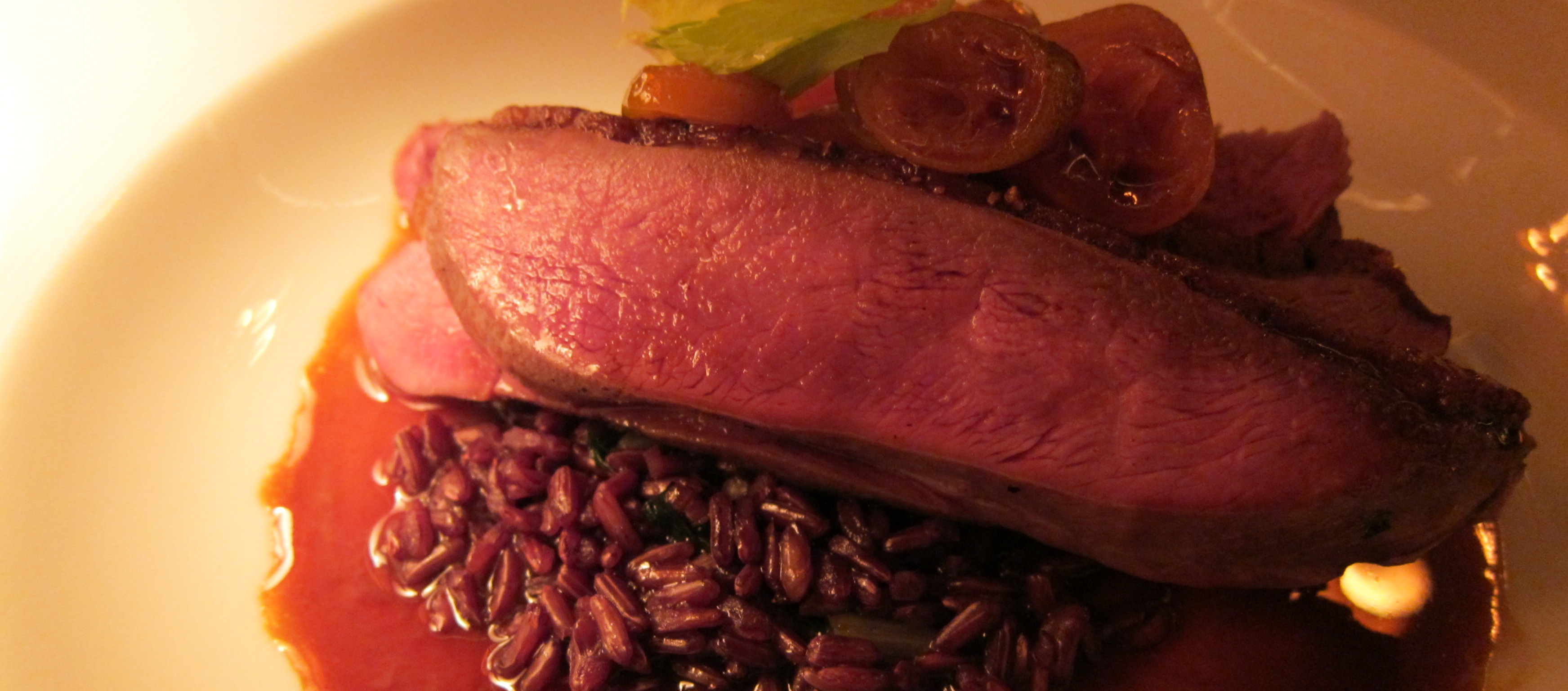
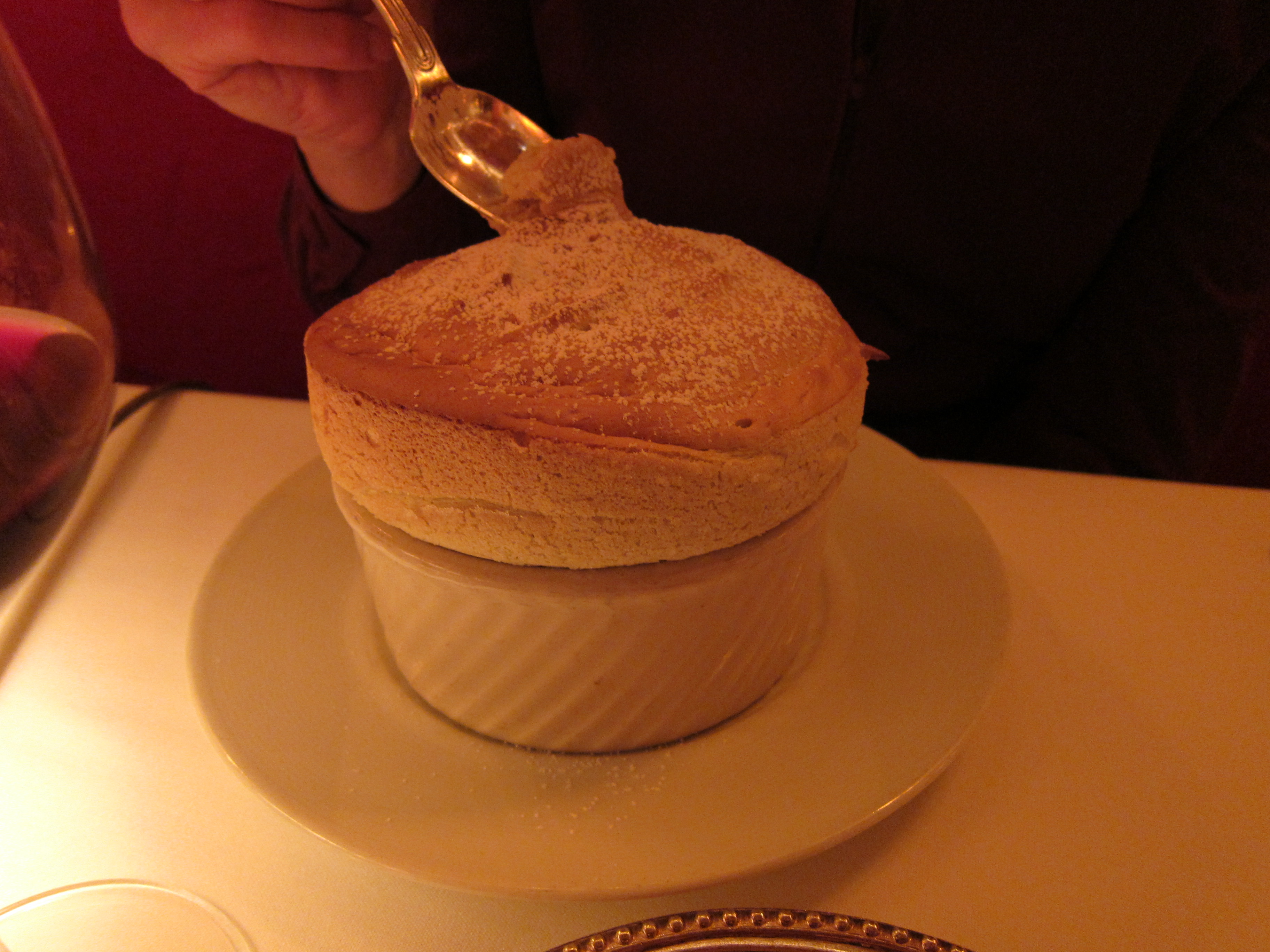


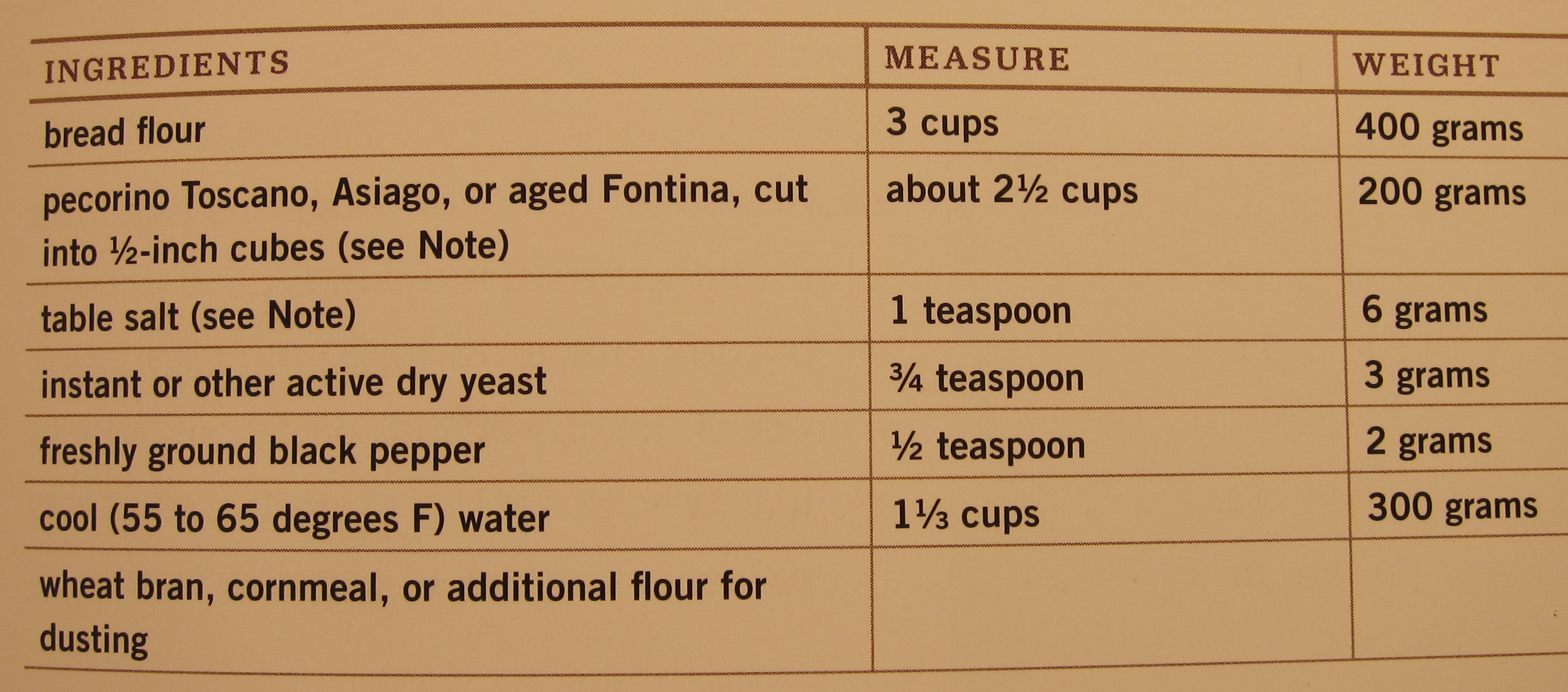
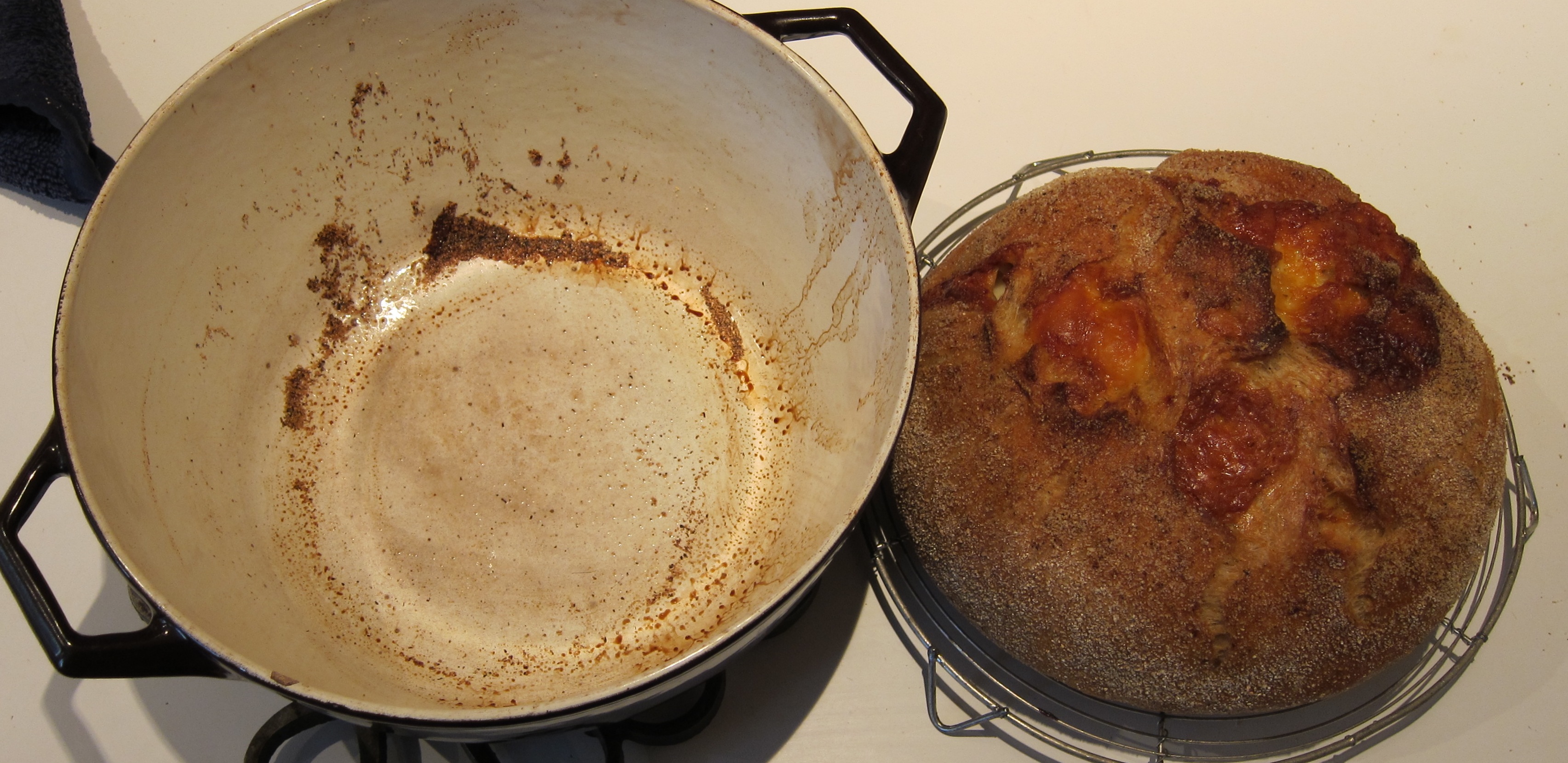

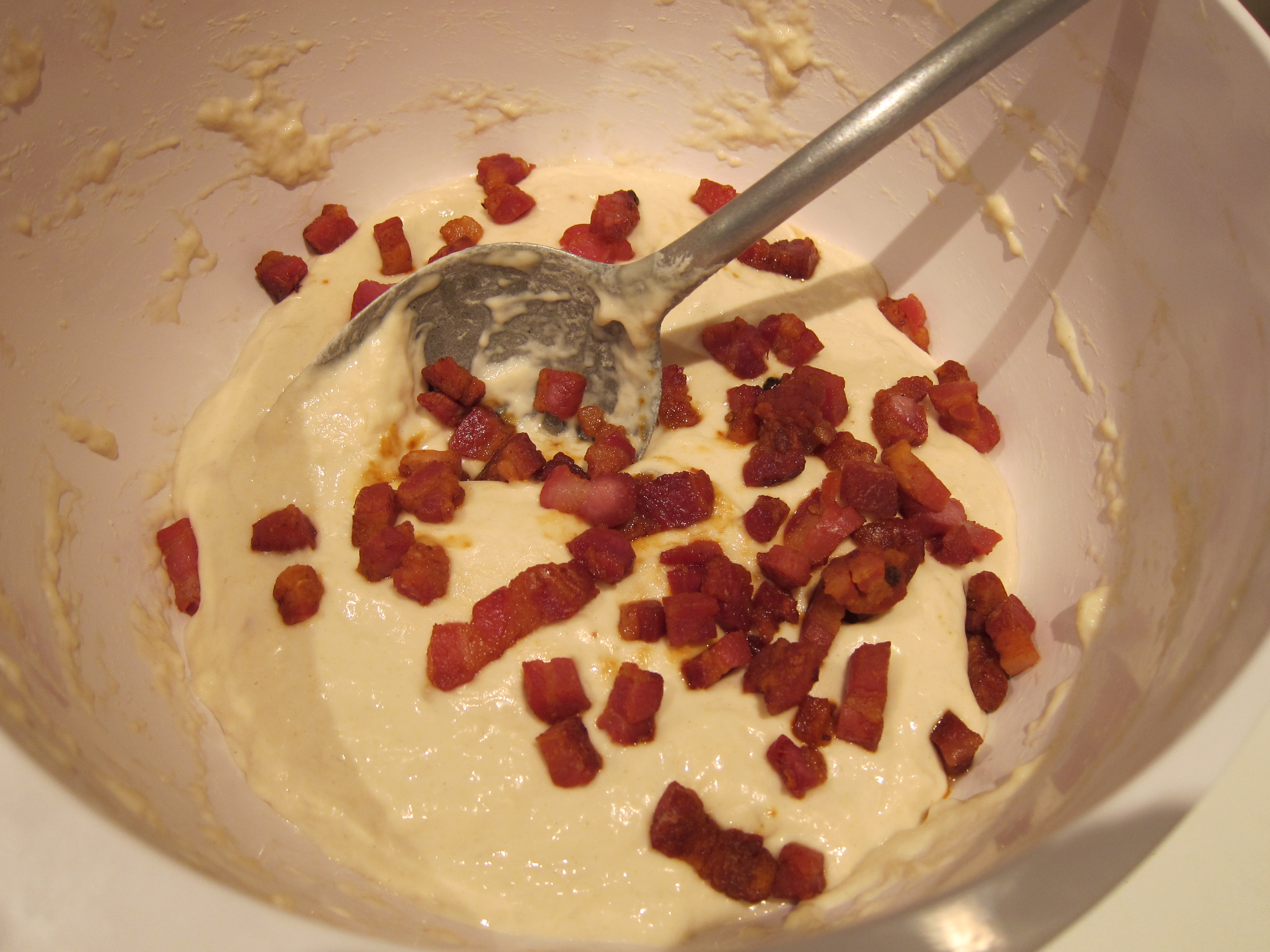
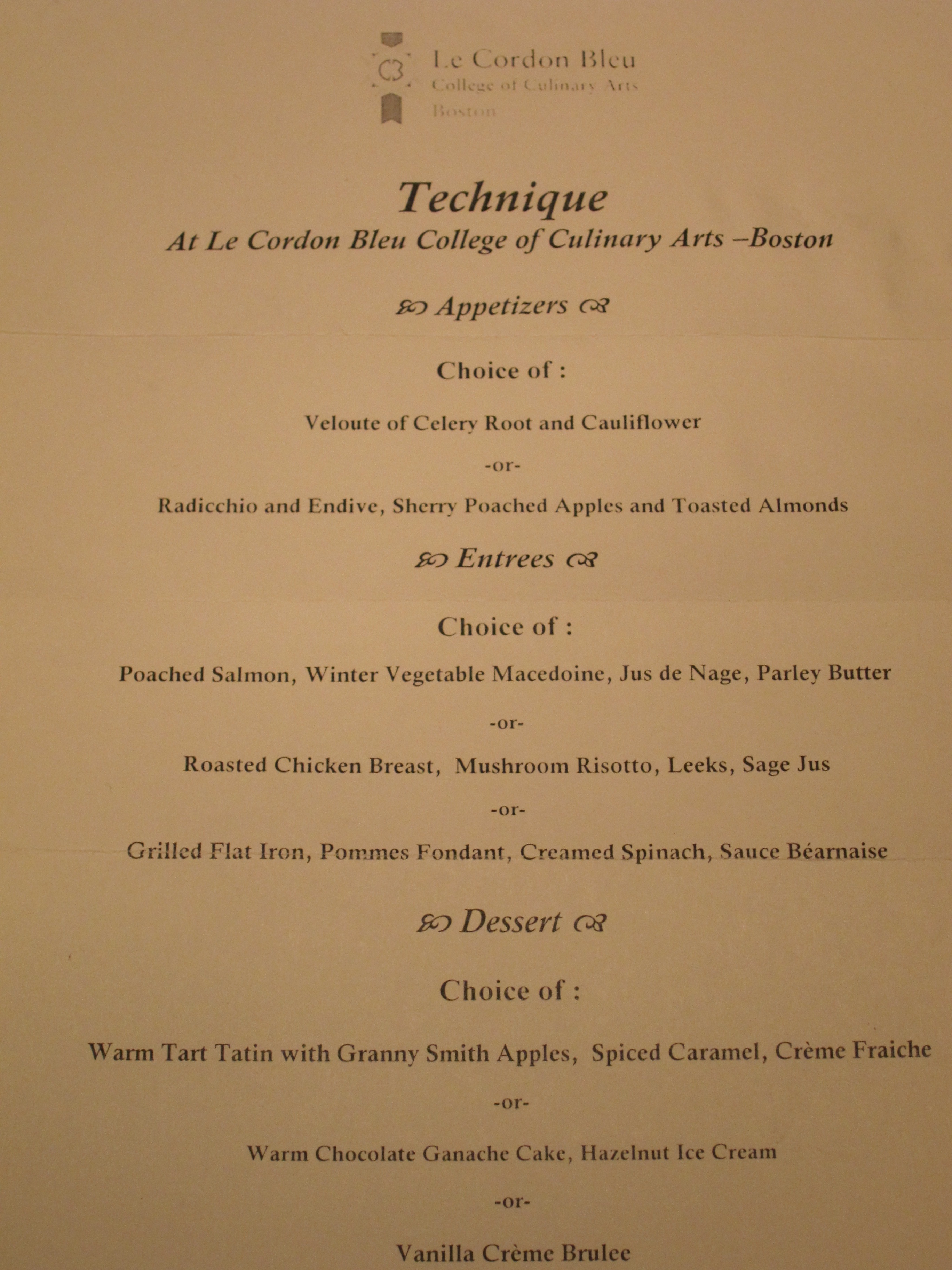

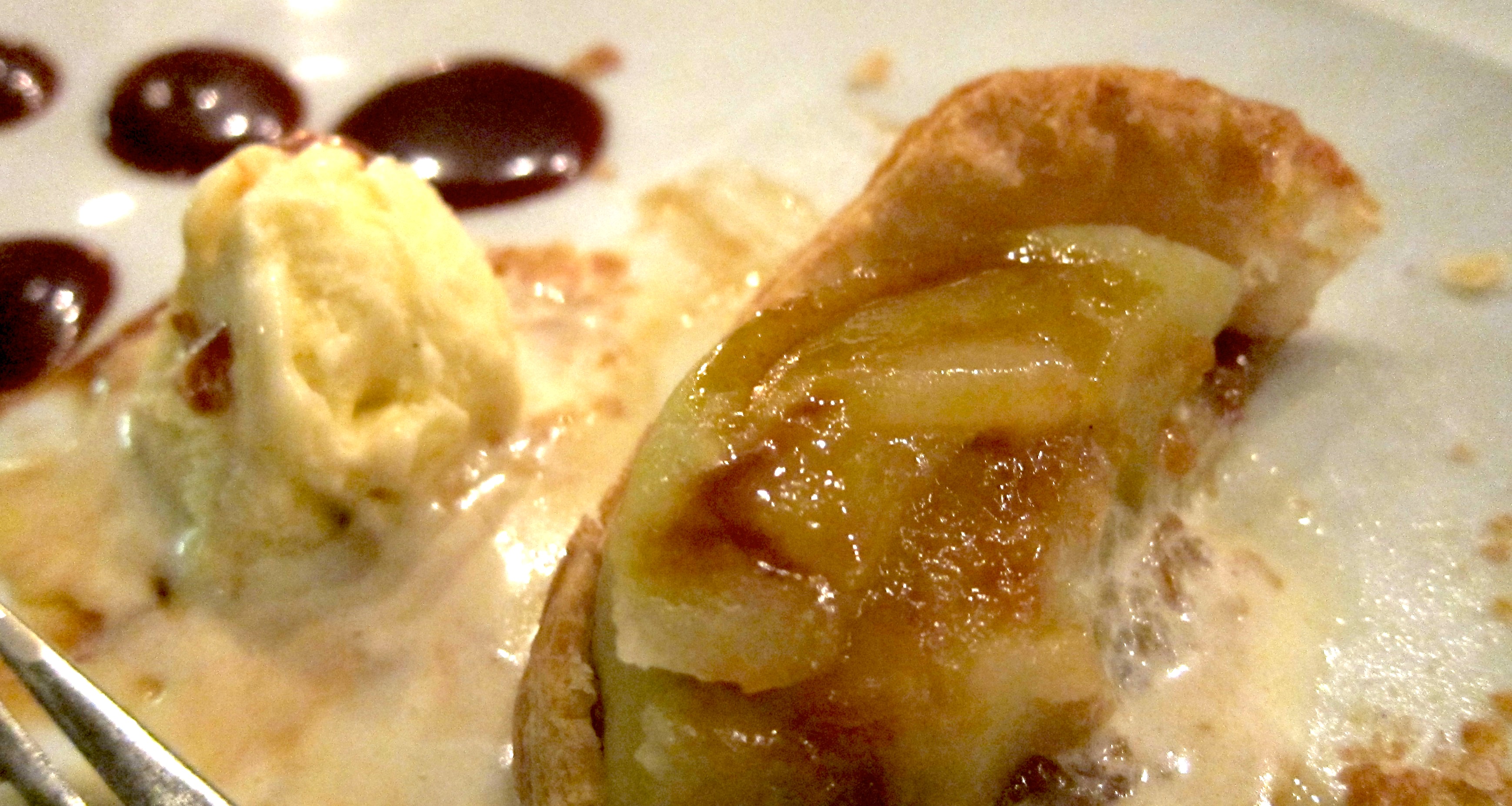
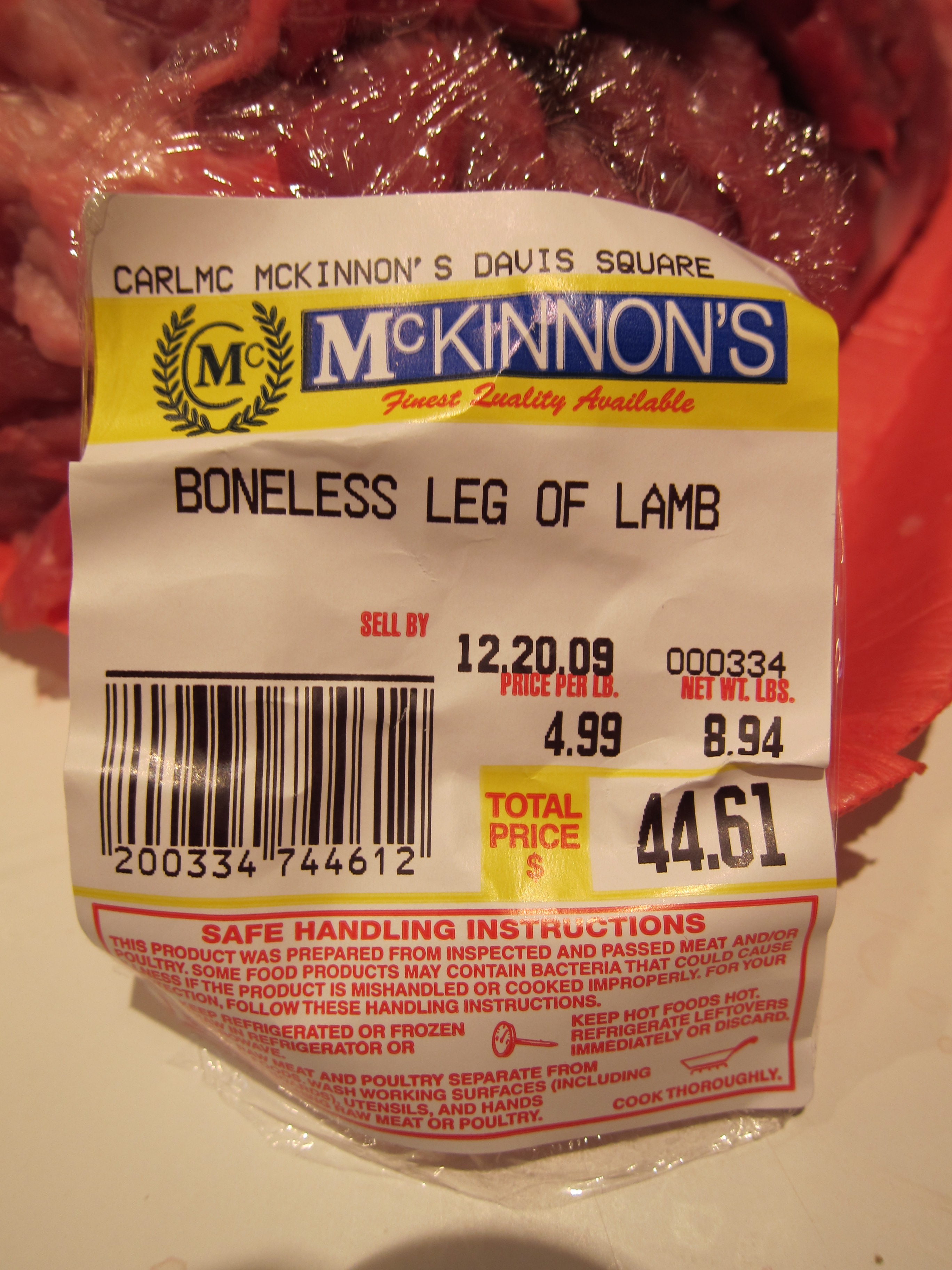
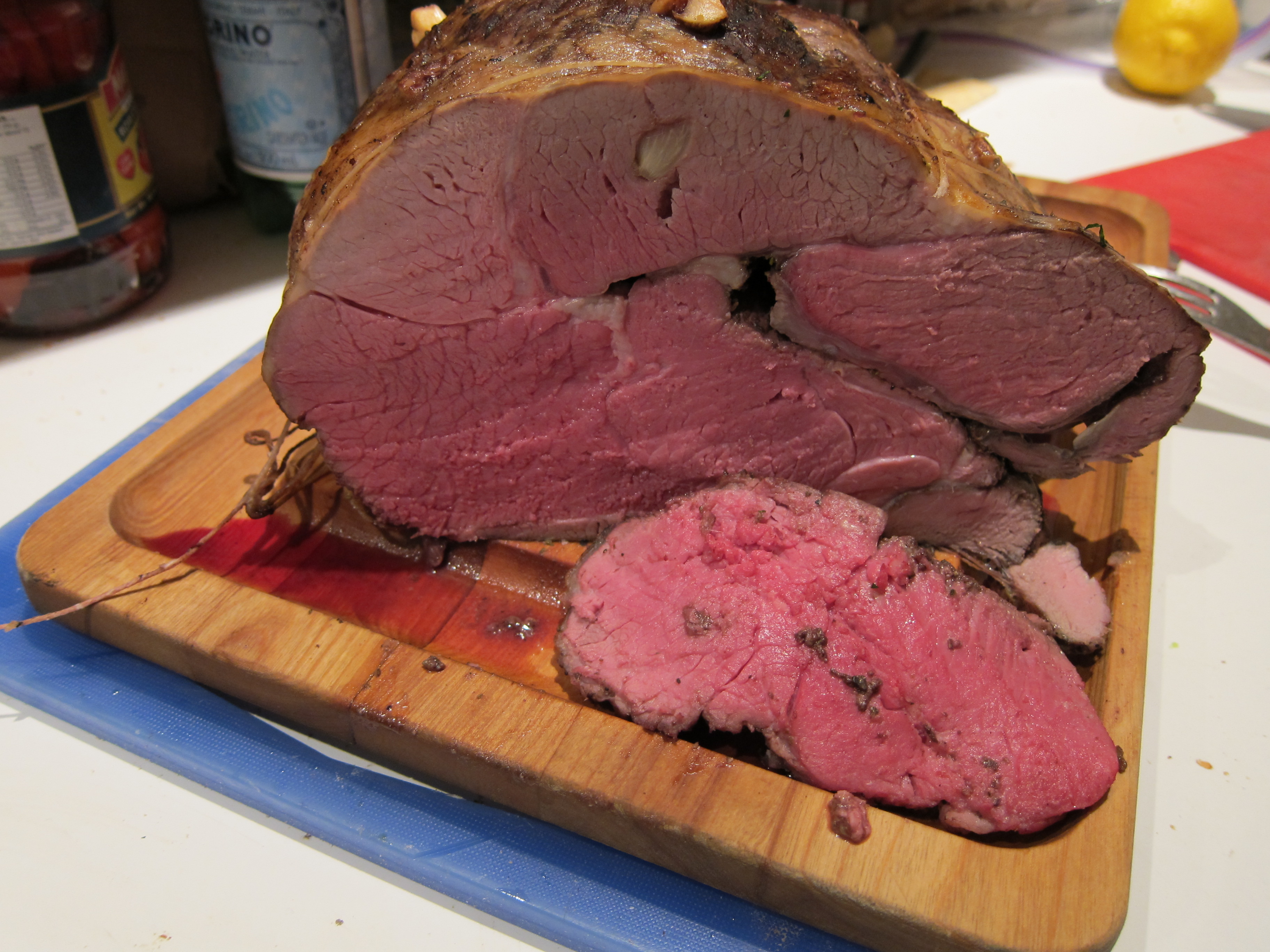
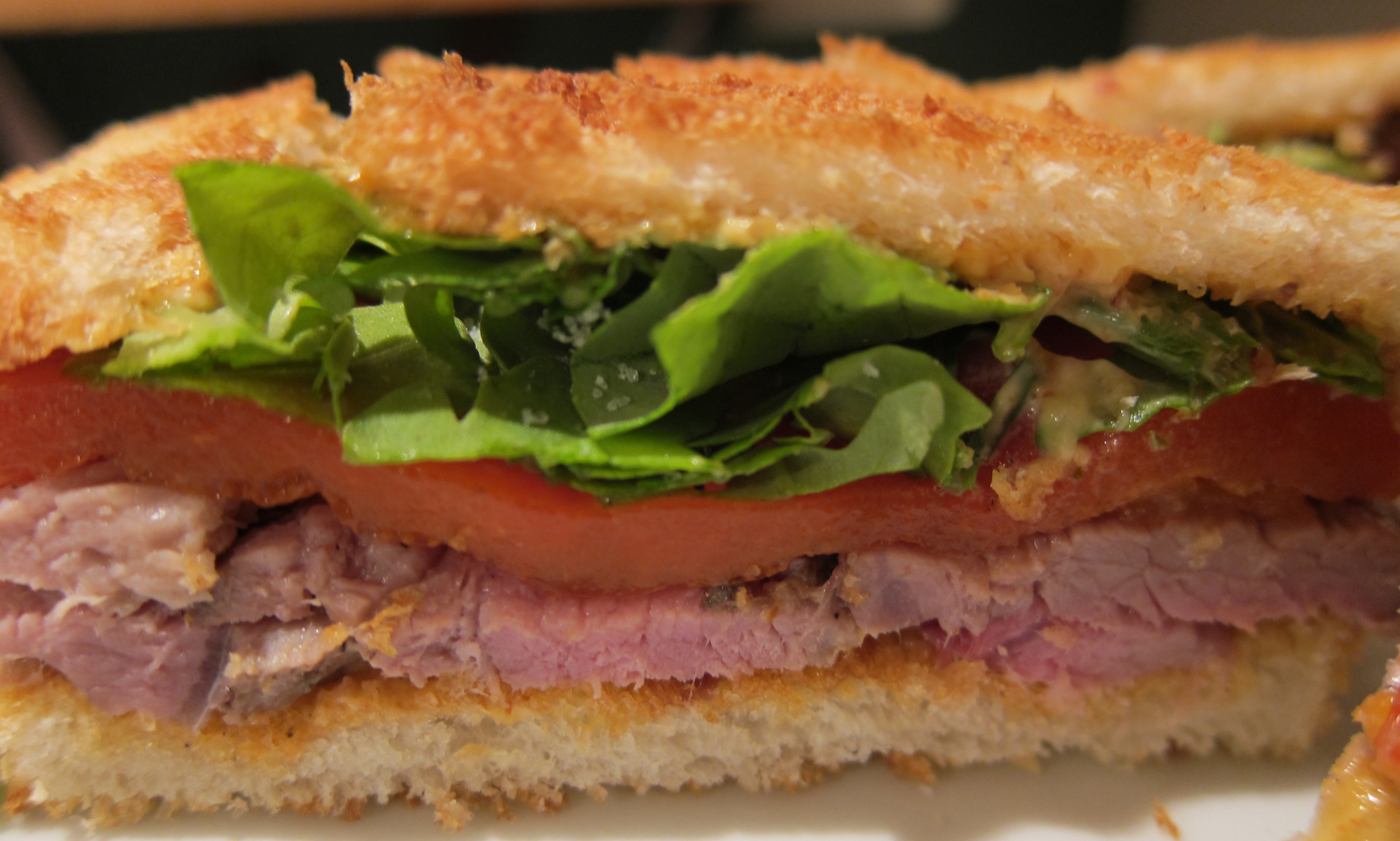



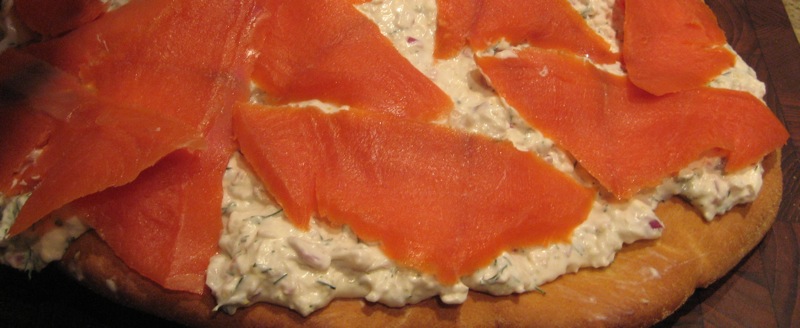
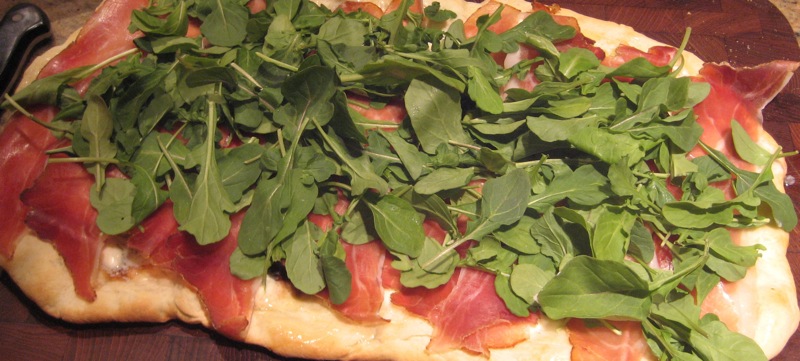

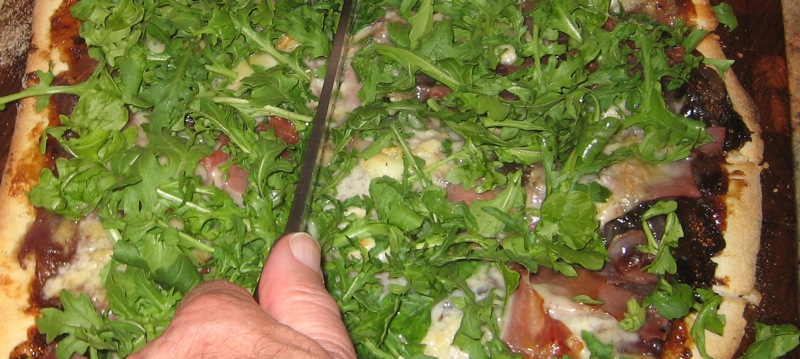
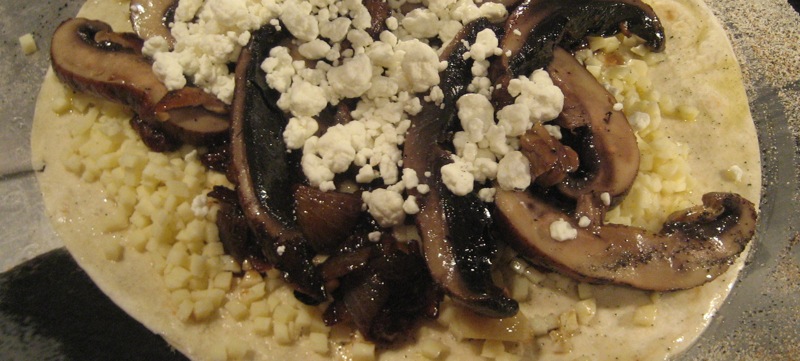


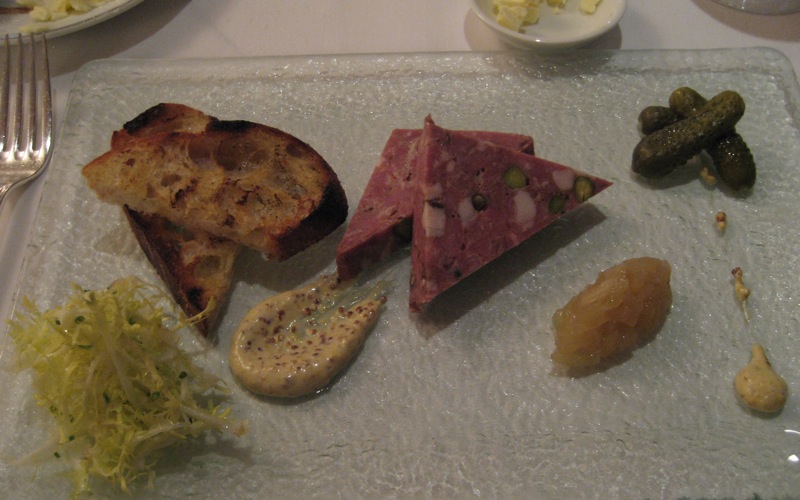
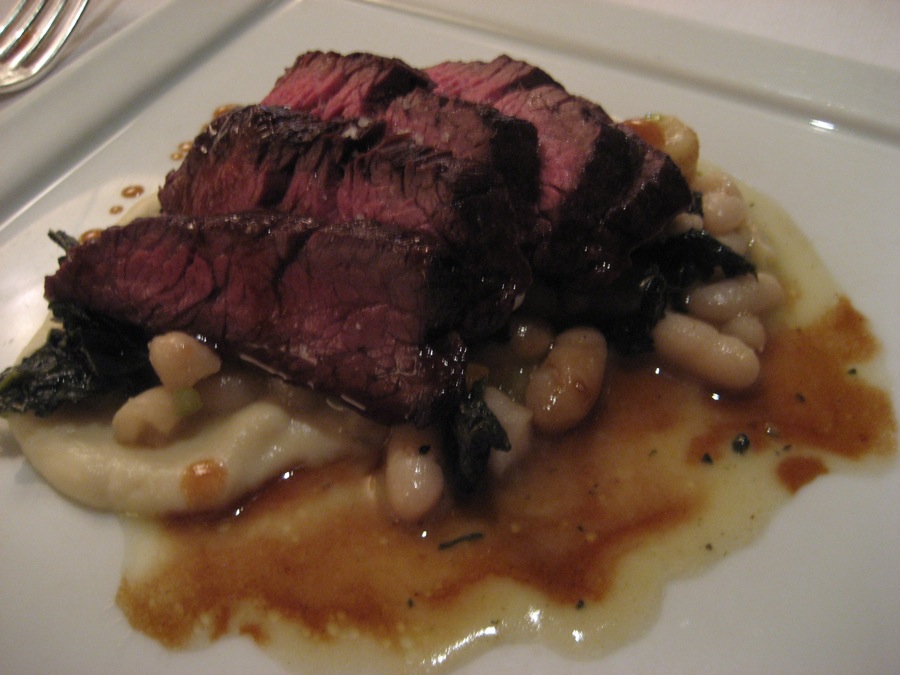
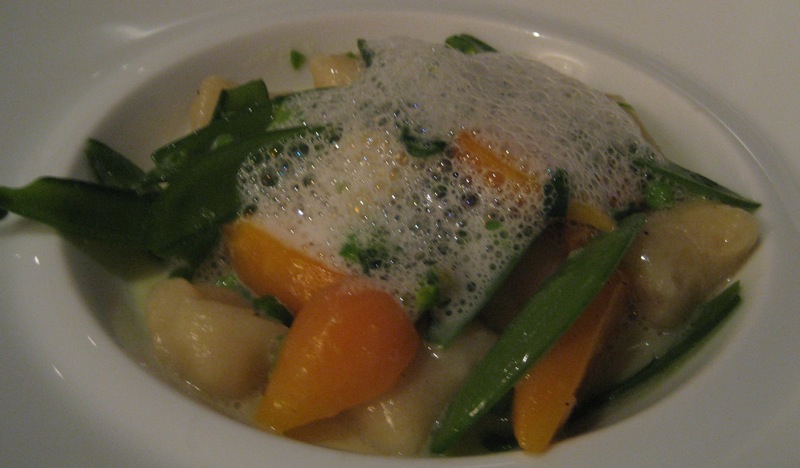
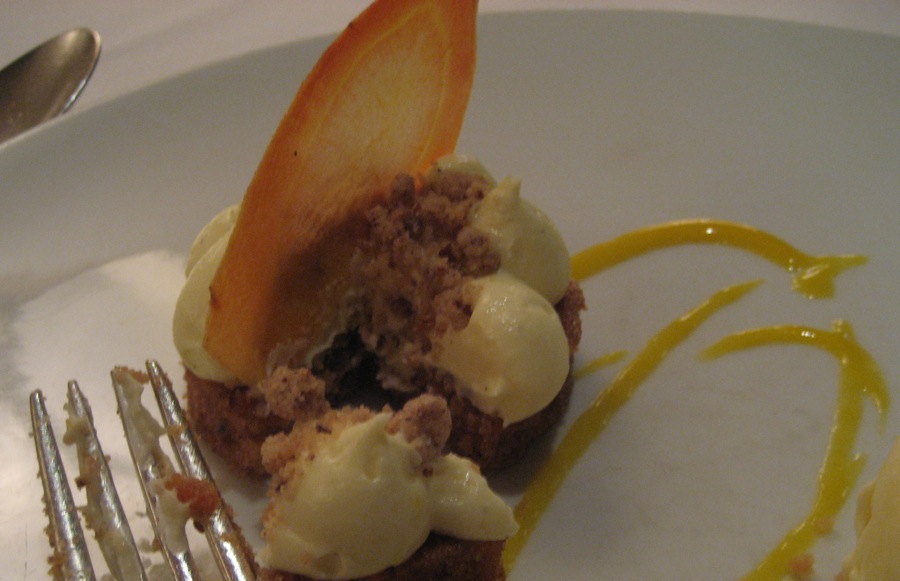
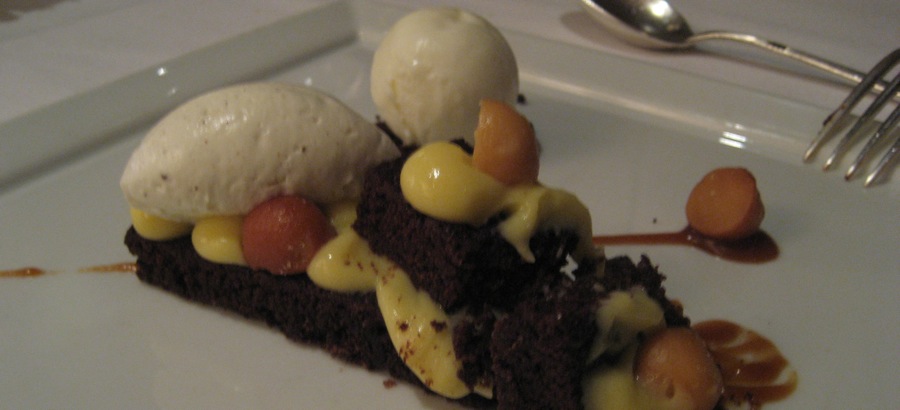
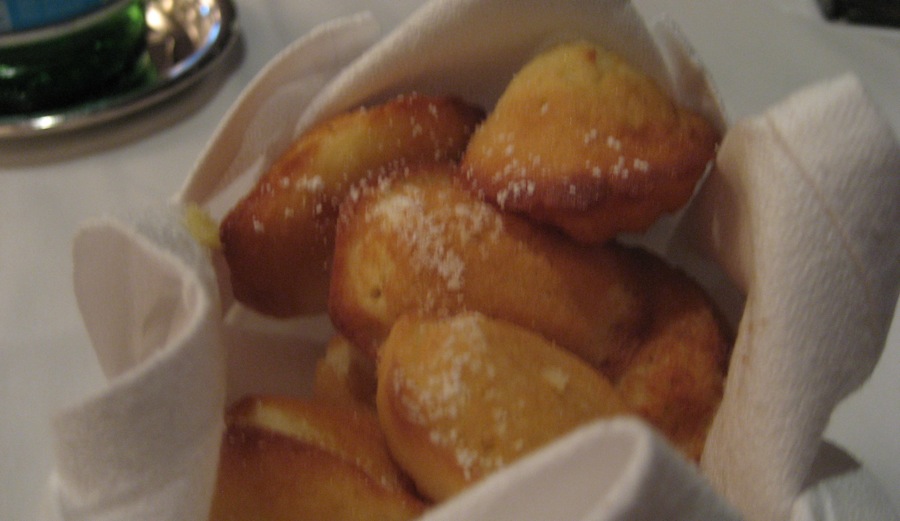
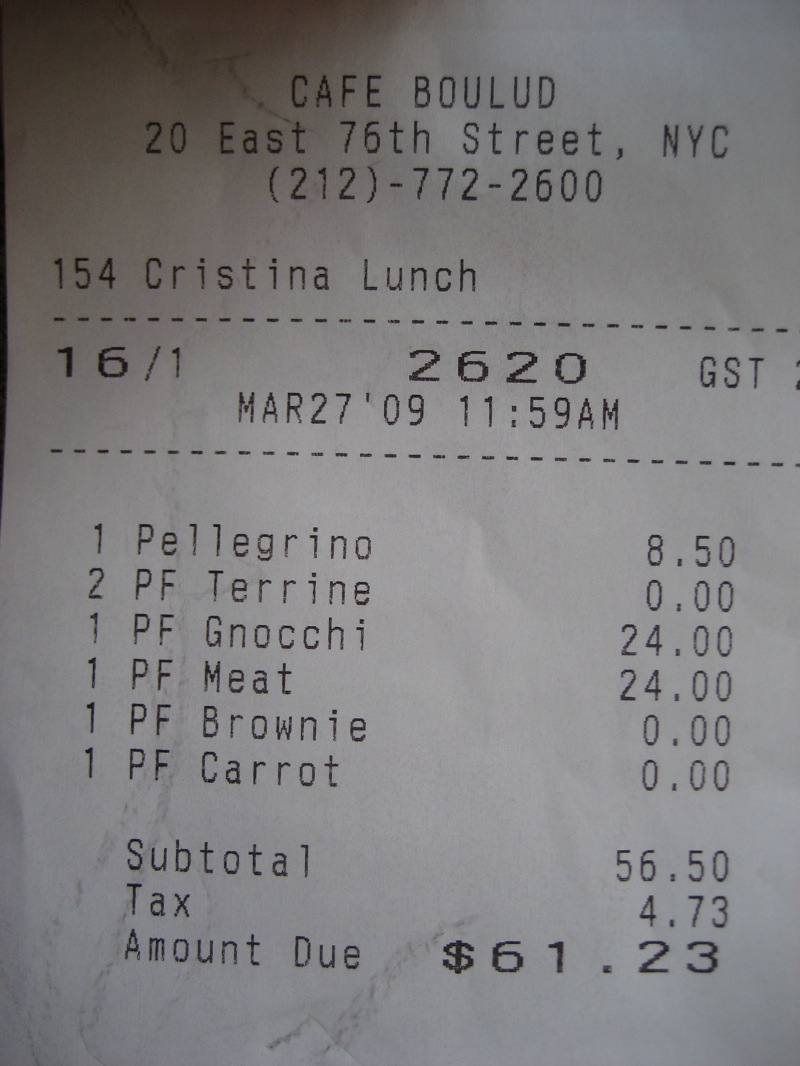
Recent Comments